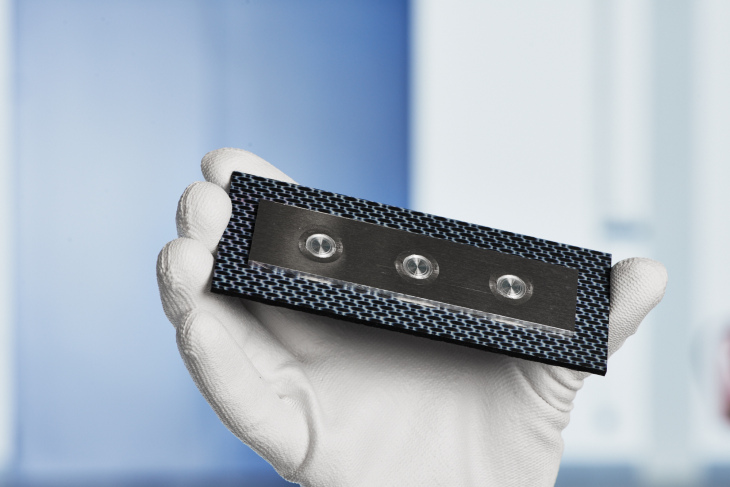Carbon Is Cleverly Bound with Metal: HZG Scientist Receives Henry Granjon Prize for New Methodology

A compound of carbon material and metal with the " Friction Spot Joining " method Christian Schmid/Helmholtz-Zentrum Geesthacht
The Henry Granjon Prize is awarded for outstanding publications in four categories carried out by emerging researchers working toward a master's thesis or doctoral dissertation in the field of joining technologies.
Dr Seyed Goushegir is awarded the prize for his research on new solid state joining processes for manufacturing metal CFRP joints. Joints made of metal and CFRP, known as metal-CFRP hybrids, are utilised in roof panels or window columns in modern automobiles (CFRP stands for carbon fibre reinforced plastic). The industry is therefore searching for welding methods for these challenging joints.
The method used by Goushegir for binding metal and CFRP through overlapping, is called Friction Spot Joining. The metal is thereby made selectively pliable through the frictional heat of a rapidly rotating sleeve. While the overlying CFRP is only melted at the surface, the underlying metal layer becomes soft and pliable.
When the rotating sleeve retracts, a slight deformation of the CFRP occurs in the metal layer. The two different materials are thereby joined firmly and permanently. The significant advantage: the procedure is fast, economical and environmentally friendly because this technology does not use any adhesive whatsoever.
“This prize for Seyed Goushegir demonstrates once more what an outstanding emerging scientist he is,” says group leader at the Institute of Materials Research and HZG joining expert, Prof Sergio Amancio. “He has further developed the technological groundwork so compellingly that this new method has already progressed to a highly advanced level.” Industrial application of the new process has thereby become possible in a much shorter period of time. Amancio explains that the first projects with industry partners are in the pipeline.
The Iranian-born Goushegir was employed at the Helmholtz-Zentrum Geesthacht from 2011 to 2016. During this time, he completed his doctoral studies at the Technical University Hamburg. He is now a researcher at the Ilmenau University of Technology.
http://www.hzg.de/public_relations_media/news/062636/index.php.en
Media Contact
All latest news from the category: Awards Funding
Newest articles

High-energy-density aqueous battery based on halogen multi-electron transfer
Traditional non-aqueous lithium-ion batteries have a high energy density, but their safety is compromised due to the flammable organic electrolytes they utilize. Aqueous batteries use water as the solvent for…

First-ever combined heart pump and pig kidney transplant
…gives new hope to patient with terminal illness. Surgeons at NYU Langone Health performed the first-ever combined mechanical heart pump and gene-edited pig kidney transplant surgery in a 54-year-old woman…

Biophysics: Testing how well biomarkers work
LMU researchers have developed a method to determine how reliably target proteins can be labeled using super-resolution fluorescence microscopy. Modern microscopy techniques make it possible to examine the inner workings…





















